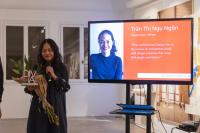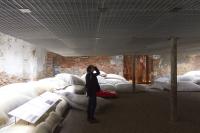Habu Community Learning Center
Onomichi city, Hiroshima, Japan
Innoshima, known for its history of the Murakami pirates and its shipbuilding town, currently has a population of approximately 20,000 people, with a declining birthrate and aging population. The project was selected through an open proposal in 2018 and began in order to relocate a dilapidated community center on the site of the former Habu Elementary School, which closed in 2015 and only the gymnasium and field continue to be used as community facilities.
The site is located a little inland from the prefectural road along the coast, with a landscape typical of the Setouchi Inland Sea, with houses lined up on a slope with mountains in the background.
The volume and roof of the community center were divided to a scale similar to that of private houses in the town, creating a form that looks like they are clustered together, and materials sampled from the townscape were used. The aim was to create a building that would blend in with the Habu landscape, with the roofs overlapping and disappearing amidst the height differences.
The volume of each living room, which is divided into the size of a private house, has boundaries between corridors and rooms, but I tried to make the partitions as vague as possible. Sometimes they are clearly separated, sometimes they are loosely connected, and the size changes as needed, becoming integrated with the terrace and becoming an outside space, or expanding and contracting.
The hall is centered around a large hall, with medium and small halls, and a hall warehouse located on three sides, and there are movable partitions that create boundaries between each hall. By opening the partitions, the large, medium, and small halls will be integrated into one large hall that can accommodate 350 seats with a fan-shaped seating arrangement. By closing all the partitions, you can use four rooms of different sizes at the same time. Furthermore, the hall is polygonal with many connecting surfaces so that it can be used continuously with the entrance lobby and plaza. It is a plaza-like space with no fixed shape, with three spaces that change freely and are connected to the lobby and the outdoors.
Hiroshima Prefecture suffered severe damage from heavy rains in July 2018, and the site, which has a cliff behind it, was also subject to a review of the steep slope warning zone, and the building was relocated to the center of the site. Each volume, arranged at an angle around a polygonal hall, faces out in different directions towards street corners and plazas, and the warm wooden roof welcomes people. The verandah space under the roof is a haven for people of all generations, including not only those who visit for a purpose, but also children playing on the field and multipurpose plaza, users of the gymnasium, and people holding meetings on the veranda.
- Architects
- Coelacanth and Associates Inc.
- Location
- Onomichi city, Hiroshima, Japan
- Year
- 2021
















